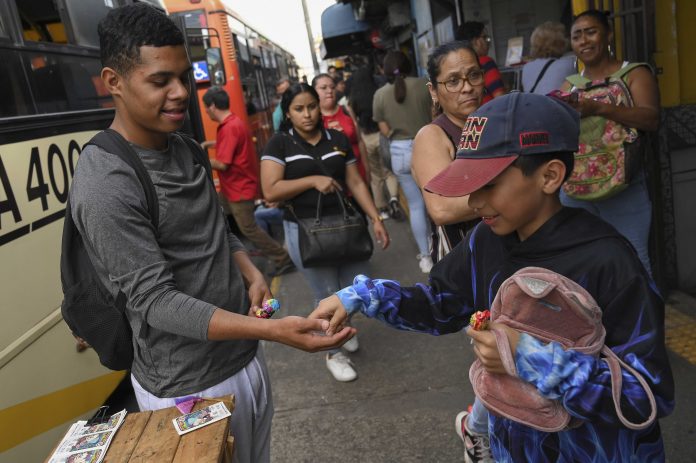
By JAVIER CORDOBA
Associated Press
SAN JOSE, Costa Rica (AP) — Costa Rica, one of the world’s great refuges for people fleeing persecution, is tightening its generous asylum policies in the face of an overwhelmed system.
President Rodrigo Chaves, who took office in May, said Costa Rica’s system is being abused by economic migrants. The changes he decreed took effect this month.
Despite having only 5 million citizens, the Central American country trailed only the United States, Germany and Mexico in the number of asylum applications it received last year, according to the United Nations High Commissioner for Refugees.
Chaves first warned of the changes last month during a sudden influx of Venezuelan migrants stranded by a change in U.S. border policy. But it is Nicaraguans who account for nearly nine out of 10 of the applicants.
“The (immigration agency) tells us that 90% or more of the people don’t qualify, so we are allowing the good cause of asylum to be abused by hundreds of thousands of people — it’s that easy,” Chaves said.
The president complained that Costa Rica has been spending $300 million a year to attend to the asylum seekers, draining resources for health and education, and international support has been insufficient.
The United Nations said that its International Organization for Migration and High Commissioner for Refugees, or UNHCR, had disbursed $94 million since 2018 to support migrants and asylum seekers in Costa Rica.
The exodus from neighboring Nicaragua, amid a brutal crackdown on popular protests there in 2018, swamped the asylum system long before Venezuelans became a visible presence in the streets of San Jose.
The arrival of Nicaraguans accelerated last year as President Daniel Ortega’s government cracked down on political opponents ahead of national elections. Ortega coasted to a fourth consecutive term after potential challengers were locked up. Arrests have continued this year, targeting critical nongovernmental organizations, press outlets and clergy.
In 2012, Costa Rica received barely 900 asylum applications. In 2018, that number reached nearly 28,000. And through September of this year, it was already more than 67,000.
Now there are more than 220,000 pending applications to resolve.
Aiming to unclog the system, the government has also created a special immigration category for people from Cuba, Nicaragua, and Venezuela — nationals who make up 96% of the asylum seekers. They would be eligible for a two-year work permit in exchange for dropping their asylum cases, if they weren’t really in danger.
This, of course, would also likely make them ineligible for asylum in other countries, including the United States.
Even before Chaves decreed the changes, there was evidence that more Nicaraguans were opting to migrate toward the United States than had previously been seen. Advocates believe the lengthening wait for asylum in Costa Rica and less favorable job prospects were responsible.
Under Chaves’ reforms, asylum seekers must enroll in the social security system and no longer receive an expedited work permit, which had been essentially automatic. Access to legal employment can be critical to being able to wait out the lengthy asylum process.
Asylum seekers must now apply within a month of entering Costa Rica, and can’t leave until their case is resolved, otherwise their applications will be cancelled. Those crossing another country to reach Costa Rica must justify why they did not seek asylum in that other nation.
The UNHCR in Costa Rica said it is reviewing the changes, and “advocates for using internationally recognized procedures so that the proper authority evaluates case by case and makes fair decisions, following due process and in full adherence to international standards and the human rights of asylum seekers.”
In the case of Nicaraguans, who have a long history of seeking safety in Costa Rica dating to Nicaragua’s revolution in the late 1970s and the Cold War’s Contra conflict in the 1980s, they are largely absorbed by an existing diaspora. A large informal settlement in San Jose has been around for decades and is essentially a Nicaraguan neighborhood.
Outside the capital, many Nicaraguans have chosen to stay closer to their homeland in northern Costa Rica, where they try to scratch out a living in agriculture.
The changes have left asylum seekers in Costa Rica unsure about the way forward.
“I asked for asylum to have stability, but honestly with these changes you don’t know what’s coming and if it’s better to drop the case or not,” said María López, a 35-year-old Nicaraguan. “I’m going to wait to see what happens with all of this.”
The uncertainty extends to organizations supporting asylum seekers.
Karina Fonseca, national director of the Jesuit Service for Migrants, said “one of the most complicated measures is not being able to leave the country while your case is being processed.”
“That has implications because the profile of those entering Costa Rica recently are humans rights activists, defenders, professionals, people who are going to see their initiatives limited,” Fonseca said.
















